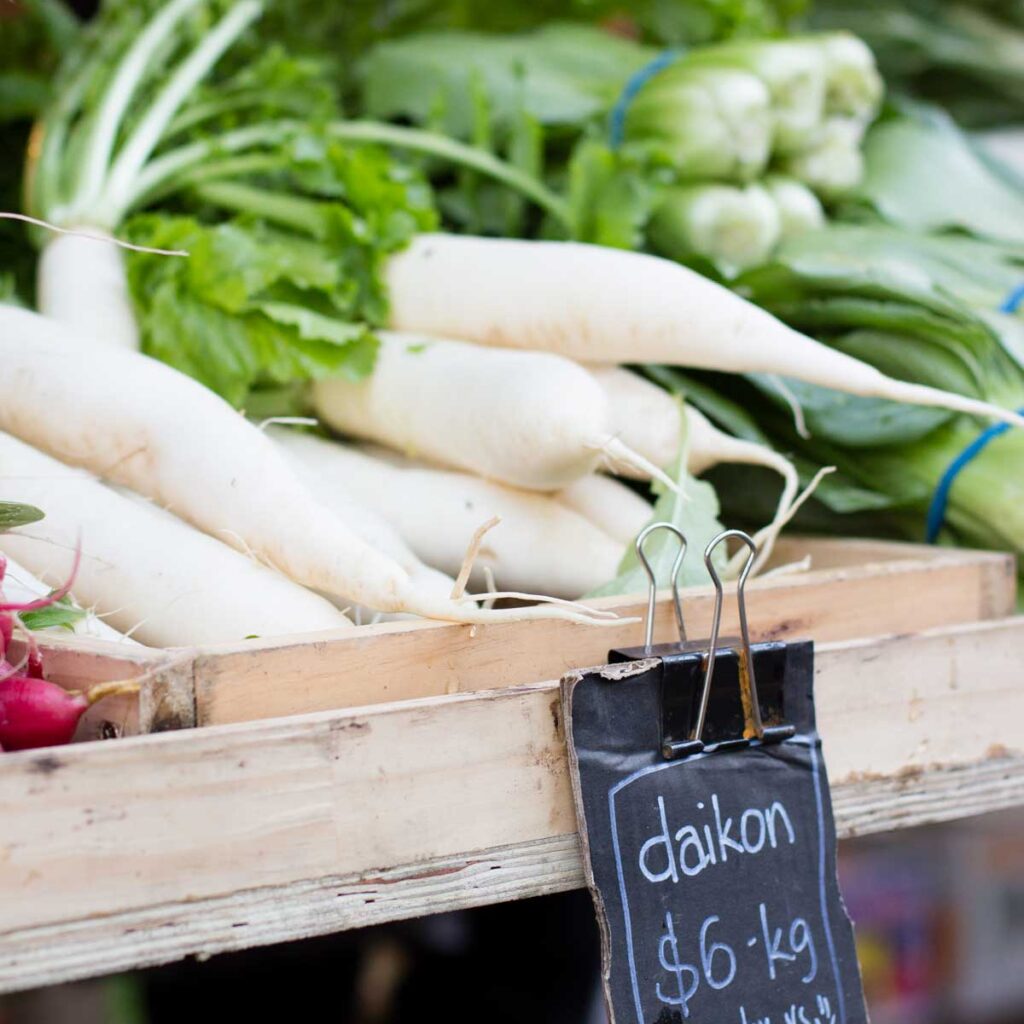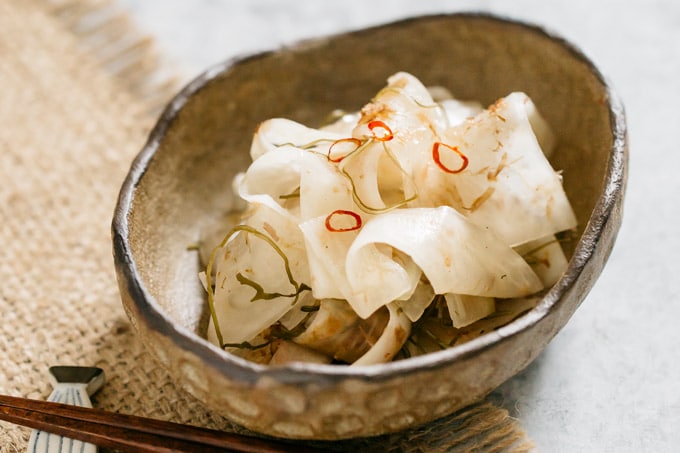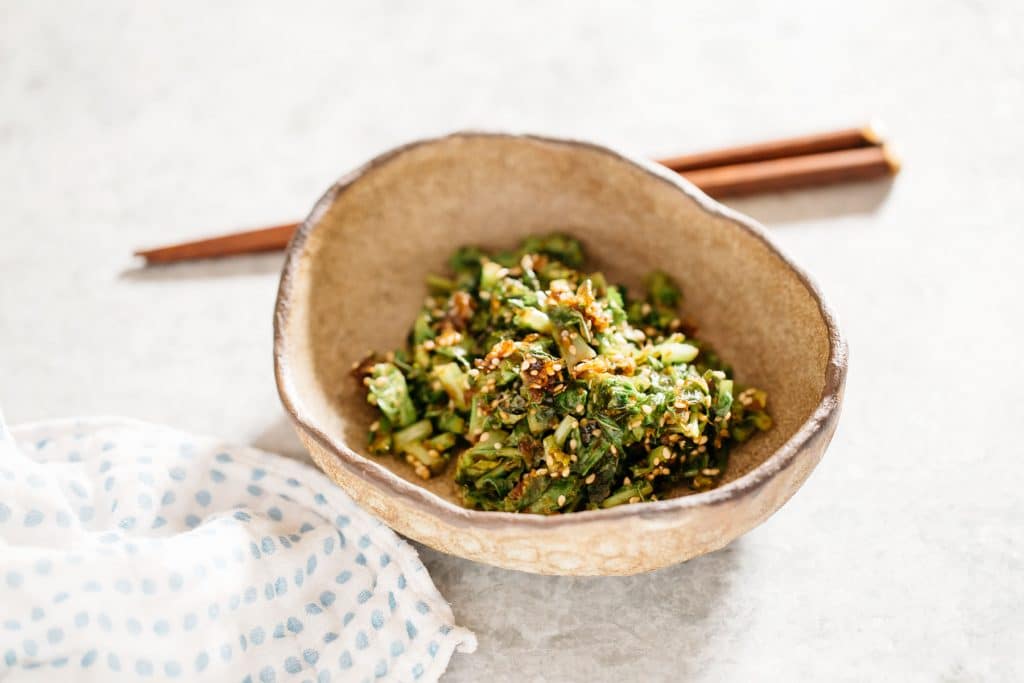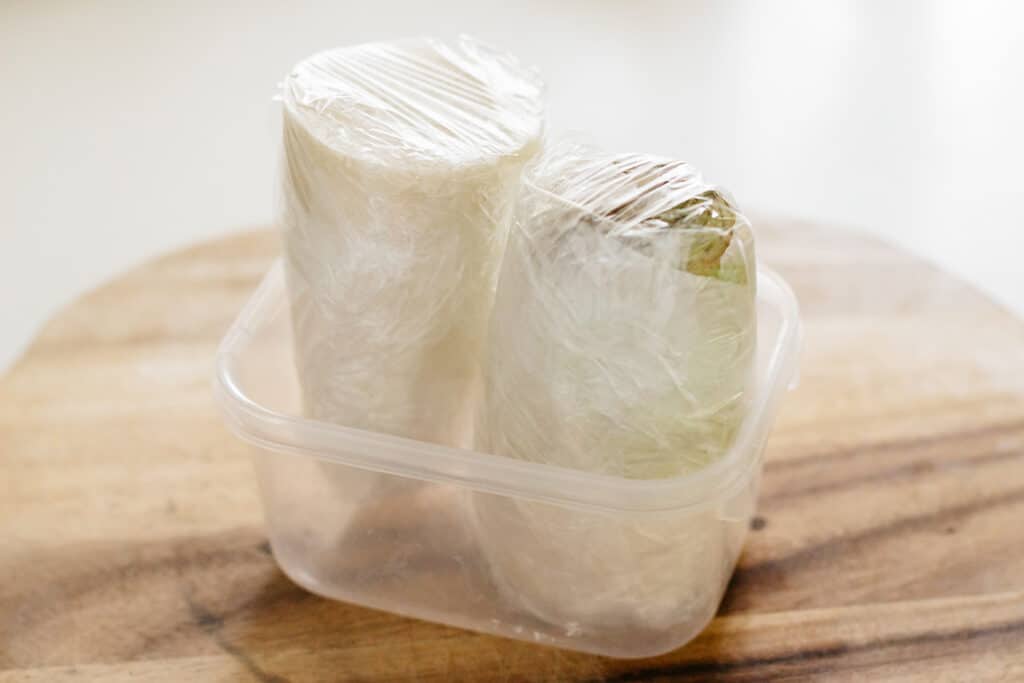When you peruse Japanese recipes, chances are you will discover a strange ingredient – the daikon radish. After you read this guide, this vegetable won’t be strange anymore, it will be as familiar as a potato.
Japanese people love Daikon radishes because they are versatile vegetables that can be cooked in a variety of dishes. You can enjoy the whole daikon from leaves to root. Keep reading this guide and you’ll discover how the Japanese use different parts of this white radish with a variety of cooking methods that suit each part of the plant, and how to store it correctly too.

Table of contents
What is Daikon?
Daikon is a root vegetable – in fact, you can tell what it is just by reading its name. 大(large) 根(root) literally means large root. So it is a large root vegetable that belongs to a cruciferous vegetable group just like cabbage and broccoli.
Although it originated on the Mediterranean coast and people in ancient Egypt, Greece, and Rome enjoyed it long before the Japanese did, it is the most familiar and popular root vegetable among Japanese people. Both percentages of production and consumption of the vegetable by Japanese are very high in the world.
In Japan, there are various local varieties, such as Aokubi (commonly distributed through the market in Japan), Miyajima, Moriguchi, and Sakurajima. They are all absolutely delicious!
Daikon Nutrition Benefits
Daikon is really good for your immune system and it helps give you healthy skin too. Plus, it has lots of antioxidants that aid in protecting your body from some diseases.
It is an excellent source of vitamin C – which is really important for strengthening your immune system. It also has the digestive enzyme diastase in its roots. This is a very important enzyme that turns foods into energy that your body can use. And who couldn’t use a bit more energy these days? I certainly could!
The daikon radish leaves are also really nutritious too. They have a large amount of carotene, vitamin B, C, D, and E. Moreover, this Japanese radish is such an all-purpose vegetable so it can be enjoyed in various dishes such as pickled daikon, salads, oden, stir-fried dishes, soups condiments.

Where To Buy Daikon Radish
Daikon is in season in winter, however, you can buy it throughout the year in Japan. I can only speak for Australia where now I live, but as Japanese cuisine becomes more popular so does this white radish. Now I can buy this special vegetable from local fresh produce markets in winter and also from Japanese/Asian grocers almost year around.
If you can not find it in your local shops, you can grow daikon from seed. It is not a difficult vegetable to grow and you can get Radish Seedseasily from online shops. I found mine from Bunnings.

How to Pick Good Daikon?
Choose the ones which are firm and taut to the touch and quite solid and heavy. Also, the good ones have white and smooth skin with evenly spaced small holes which are straight down to the bottom. I have heard that if those small holes are uneven and distorted, then the vegetable will have a strong, pungent taste. Thus, I always choose the one that has fresh leaves. Leave the discoloured yellow and wilted ones behind!
The leaves are edible too, so if you can buy them with leaves, you get more for your money. If the leaves are cut, avoid the cut area as it is dry and pithy. If new leaves are shooting avoid buying these because these are signs of older age.
Daikon Substitutes
If you don’t have access to daikon radish, there are still some vegetables that you can use as close replacements. Try a turnip (kabu in Japanese). It has the same texture and is full of gut-healthy fiber.
A radish (Hatsuka daikon) is in the same family so it has a very similar taste.
Finally, kohlrabi or winter melon can be substituted where you need Japanese radish in some recipes because it has a very similar flavor profile and consistency.

How Daikon is Used in Japanese cooking?
Every single part of the daikon radish is used in Japanese cooking. Here is a bit more information about how to use the leaves, the middle, and the bottom of this amazing vegetable.
Daikon Leaves
Use the leaves the same way you use lettuce. I like it in Ohitashi salad, stir fry, and also it will make good furikake.
Daikon Top
The top part where the stems start is juicier and sweeter than the rest of it. That’s why this part is suitably served raw as salad and in Oroshi (grated).
The Middle
The middle part has a balanced taste of sweet and spicy and the texture is soft firm. So it is recommended to use it in dishes that can enhance the taste and texture of Daikon such as Oden.
The Bottom
This part has a spicer taste and contains less juice. Therefore seasonings easily penetrate through so it is recommended to use for pickles and simmered dishes or as an ingredient for a soup such as miso soup.

Which part is the best for Daikon Oroshi (grated Daikon)?
If you have a sweet tooth and prefer sweeter recipes, then you should use the top of the radish for daikon oroshi. Cut it vertically and grate it along the fibres. You can also reduce the spiciness by letting it set after you grate it.
On the other hand, if you prefer dishes with lots of spice and kick, then use the bottom part of the radish. Cut it horizontally, then grate against the fibres to break it right before it is consumed.

How to Store Daikon
Unless you have a large family to feed, it is hard to use the whole daikon in one go since this white radish is so large. Therefore, it is important for most people to store the vegetable properly.
It contains a lot of moisture and that moisture will be dried out from the leaves. Thus if you buy it with leaves still attached, the first thing you need to do is to remove the leaves because the leaves will deprive nutrients and water from its root. The leaves will wilt quickly so eat them on the day you but it if possible.
There are two ways to store it – in the refrigerator, and in the freezer.
Refrigerate
Wrap the Japanese radish with a kitchen paper towel or newspaper and then with a sheet of cling wrap. Keep it upright in the fridge the same as you do for Shungiku. They will keep for about 2 weeks.

Freezer
Pre-cut the radish according to how it is going to be used. Then, place them in a zip-top freezer bag in single portion sizes. Those frozen daikon pieces will be great in soup, and simmered dishes.
Also, you can freeze grated daikon. Gently squeeze to drain the juice from the grated radish, put them in a zip bag and freeze it. They will keep for about 3 weeks this way.

Healthy Recipes Using Daikon
I have used this radish in so many recipes. It’s hard to choose favourites – it’s like asking a mom to choose her favourite child! However, I did narrow the list down a bit and I am thrilled to share my favorites with you below.
Tsukemono
This is possibly my favorite way to enjoy daikon radishes. Tsukemono is a pickled radish recipe that is both refreshing and zesty. It is very simple and has both a sweet and tangy taste that will have you reaching for more.
Kouhaku Namasu
If you enjoy coleslaw, then you should try kouhaku namasu. It’s a refreshing salad with both pickled radish and matchstick carrots. Enjoy this salad on the side with some teriyaki meatballs for a satisfying dinner.
Oden
One of my favorite Japanese one-pot dishes is oden. It is a hearty and comforting dish that is best enjoyed in cold weather. It has the most satisfying combination of daikon, hardboiled eggs, chicken meatballs, mochi kinchaku, and a few other delightful ingredients.
Rafute
Daikon adds a robust flavor profile to Rafute – Okinawa braised pork belly. This recipe is both sweet and savory and tastes like a treat (but fills you up like dinner).

FAQ
A: Yes and no. For grated daikon, I would get an organically grown one and use it without peeling because food enzymes and nutrients are abundant near the skin. The skin also has an astringent taste as well so Japanese peel and prepare it in the water used to wash rice which will remove the astringent taste.
A: Yes. It will last for about three days in room temperature. In winter could be a little longer. See how to store in the above post.
A: This radish only has 2.7g net carb. Therefore it is definitely keto-friendly.
A: Yes, according to Monash University, this qualifies as low FODMAP.
I hope you are ready to go off and explore the wonderful world of daikon! Enjoy!

To eliminate bitter taste, Peel off 1/8” skin, just to seek for a delicate taste.
I am so excited to find you and your marvellous recipes. To continue my journey into Japanese food with this wealth of information is wonderful. Thankyou
Thank you Gayle 😀
I have been using Daikin I have been eating DIAKON over a month and I seen and felt the difference in my body and in my skin. I cannot do without it niw.
for the p
Thank you Shihoko for this excellent guide. I can’t wait to explore your recipes with daikon now that I’ve learnt everything I need to know about it! 🙂
You are welcome Tina, I am glad the post was useful.
Oissshhiii! Finally authentic Daikon
Hey Craig, Thank you for the comment. I am glad that you found this great information for you!